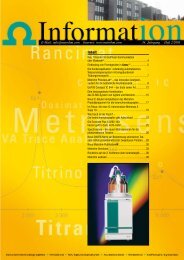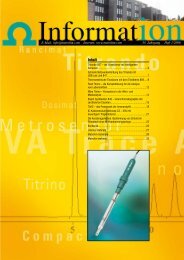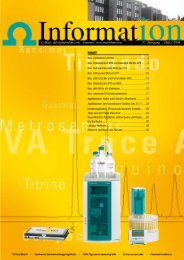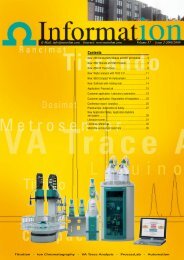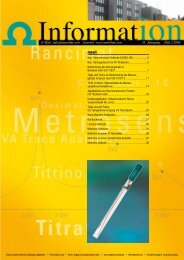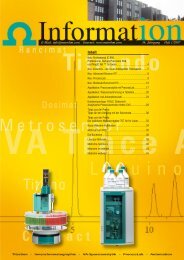What is the theoretical background of potentiometry? - Metrohm
What is the theoretical background of potentiometry? - Metrohm
What is the theoretical background of potentiometry? - Metrohm
You also want an ePaper? Increase the reach of your titles
YUMPU automatically turns print PDFs into web optimized ePapers that Google loves.
1. BASICS OF POTENTIOMETRYTroubleshootingTable 8: Possible sources <strong>of</strong> interference and remedies for ion-selective electrodesElectrodeIon-selective crystalmembraneIon-selective polymermembraneSource <strong>of</strong> interferenceD<strong>is</strong>solution processes,oxidation processesElectrode po<strong>is</strong>onsD<strong>is</strong>solution processesEffectsRough surface ➝slow response,poor detection limitsFormation <strong>of</strong> more sparingly solublesalts on <strong>the</strong> electrode surface thanwith <strong>the</strong> ion to be measured ➝ zeropoint shift, reduced linearity rangeDiffusion into <strong>the</strong> membrane ord<strong>is</strong>solution <strong>of</strong> membrane componentsCleaningPol<strong>is</strong>h withpol<strong>is</strong>hing clothPol<strong>is</strong>h withpol<strong>is</strong>hing cloth,mask interfering ionEliminate interferingcomponentsNH 3 sensorVolatile bases (amines)SurfactantsElectrolyte becomes contaminated ➝d<strong>is</strong>placement <strong>of</strong> calibration line,limited linearityMembrane becomes wetted ➝slow responseChange electrolyteReplace membrane1.4. Reference electrodesReference electrodes are usually electrodes <strong>of</strong> <strong>the</strong>second kind. In th<strong>is</strong> type <strong>of</strong> electrode a metal electrode<strong>is</strong> in contact with a sparingly soluble salt <strong>of</strong> <strong>the</strong>same metal. The potential depends only on <strong>the</strong> solubility<strong>of</strong> <strong>the</strong> salt. As a first approximation, electrodes<strong>of</strong> <strong>the</strong> second kind do not <strong>the</strong>mselves react with <strong>the</strong>solution and <strong>the</strong>refore supply a constant potential.The most frequently used reference electrode <strong>is</strong> <strong>the</strong>silver/silver chloride reference electrode (Ag/AgCl/KCl). The calomel electrode (Hg/Hg 2 Cl 2 /KCl), whichwas formerly widely used, <strong>is</strong> hardly used at all todayas mercury and its salts are extremely toxic and all <strong>the</strong>applications can also be carried out with <strong>the</strong> silver/silver chloride reference electrode. The standardhydrogen electrode SHE <strong>is</strong> also an electrode <strong>of</strong> <strong>the</strong> secondkind. It <strong>is</strong> only used for calibration purposes.Some titrations <strong>of</strong>fer <strong>the</strong> possibility <strong>of</strong> using pH glasselectrodes as reference electrodes. Even if protons aretransferred during <strong>the</strong> titration it <strong>is</strong> usually still possibleto make an accurate determination <strong>of</strong> <strong>the</strong> endpoint.1.4.1. Silver/silver chloride reference electrodeThe reference element <strong>of</strong> <strong>the</strong> silver/silver chloride referenceelectrode <strong>is</strong> <strong>the</strong> silver/silver chloride/potassiumchloride solution system: Ag/AgCl/KCl. The referenceelectrode <strong>is</strong> usually filled with c(KCl) = 3 mol/Lor saturated KCl solution. Tables 9 and 10 show <strong>the</strong>potentials <strong>of</strong> <strong>the</strong> reference electrode as a function <strong>of</strong><strong>the</strong> reference electrolyte and temperature. Each <strong>of</strong><strong>the</strong>se values has been measured against <strong>the</strong> standardhydrogen electrode under <strong>is</strong>o<strong>the</strong>rmal conditions.Table 9: Standard redox potentials <strong>of</strong> <strong>the</strong> silver/silver chloride reference electrode as a function <strong>of</strong> <strong>the</strong> temperature and concentrationTemp. (°C) 0 +10 +20 +25 +30 +40 +50 +60 +70 +80 +90 +95E 0 (mV) with +224.2 +217.4 +210.5 +207.0 +203.4 +196.1 +188.4 +180.3 +172.1 +163.1 +153.3 +148.1c(KCl) = 3 mol/LE 0 (mV) with +220.5 +211.5 +201.9 +197.0 +191.9 +181.4 +170.7 +159.8 +148.8 +137.8 +126.9 +121.5c(KCl) = sat.Table 10: Standard redox potentials <strong>of</strong> <strong>the</strong> silver/silver chloride reference electrode as a function <strong>of</strong> <strong>the</strong> concentrationc(KCl) / mol/L (25 °C) 0.1 1.0 3.0 3.5 sat.E 0 (mV) +291.6 +236.3 +207.0 +203.7 +197.084




